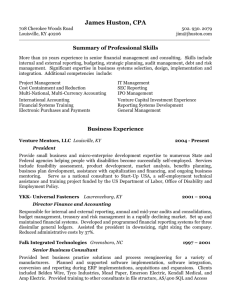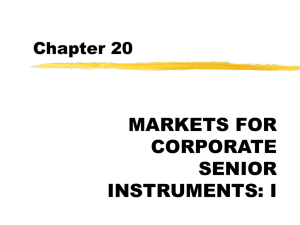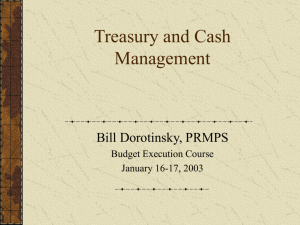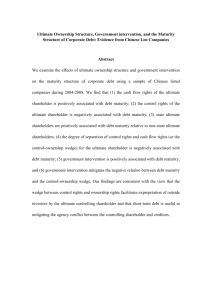Re-building Standalone Strength
advertisement
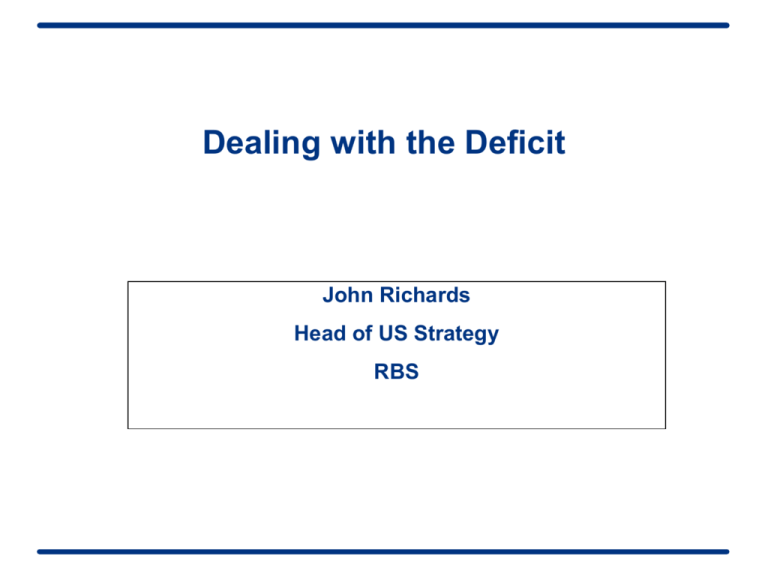
Dealing with the Deficit John Richards Head of US Strategy RBS The deficit: Is there a problem? We can finance the government deficit now because private borrowing has fallen sharply due to deleveraging and the recession. Plus, monetary policy is exceptionally accommodative. 2 Net Supply of High Quality Assets: Trending lower even before QE2 removes $600bln in Treasuries through June 2011 (bln) 2009 2010 2011 Treasury 1284 1600 1200 Agency -17 -202 -120 Agency MBS 445 -65 100 IG Corporate 239 286 159 1951 1619 1254 Total 3 Gross General Government Debt for 2010 (% of GDP) So, what’s the problem? 2011 projections of deficit to GDP and public debt to GDP levels put the US dangerously near some “bad” company. And it potentially gets worse over time. Historically, the US has been in the middle of the pack. 160% Lebanon Japan Japan's Govt. Debt is 225% 140% 120% 100% Italy Ireland Greece 80% UK France EurozoneAustria Portugal India Egypt 60% Spain US 2011 Latvia Lithuania 40% 20% 0% -13% Belgium US 2021 Iceland -11% Red = Eurozone Teal = G10 Orange = Asia Blue = CEEMEA Pink = LatAm -9% Hungary Germany Israel Canada Netherlands Malta Philippines Malaysia Brazil Argentina Turkey Taiwan Cyprus Sweden Switzerland Slovenia Finland Colombia Czech Croatia Slovakia Korea New Zealand Denmark Thailand Peru Mexico Romania South Africa China Ukraine Ecuador Australia Indonesia Venezuela Luxembourg Estonia Russia Chile Kazakhstan Poland -7% -5% -3% -1% 1% 3% General Government Balance for 2010 (% of GDP) 4 Norway Singapore Saudi Arabia 5% 7% Deficits: Why do we care? • Intergenerational wealth transfers: passing the future tax liability to our kids • International wealth transfers: Foreigners and their children will have a future claim on us and our children • Resource allocation: public vs private; efficient vs inefficient; high growth vs low growth; debt service costs become an increasing share of GDP • Geopolitical: Foreign governments, especially central banks, not individuals, generally hold US debt, giving foreign governments potentially undesirable political leverage over us • USD reserve currency status: Global trends may be moving away from the dollar • Inflation/monetization/currency debasement: Historically, this “slippery slope” has been a huge problem for many of the countries that have tried it, sometimes leading to hyper inflation and economic collapse • Higher interest rates: Interest rates are the main transmission channel through which the economy is affected. Crowding out; Credit rating; What happens when the Fed stops buying? • Loss of flexibility: Could we deal with another crisis with our finances so badly strained? • Financial strains: The rollover problem • The debt-death spiral: Forced fiscal austerity lowers GDP, which increases deficits, which forces further austerity. Greece and Ireland face this problem now. 5 The evolution of UST ownership: note increasing foreign holdings Holdings of Treasuries by Agent as % Treasury Debt Outstanding 60% 50% 40% 30% 20% 10% Households Foreigners Banks 6 Pensions + Insurers Mutual Funds 2009 2007 2005 2003 2001 1999 1997 1995 1993 1991 1989 1987 1985 1983 1981 1979 1977 1975 1973 1971 1969 1967 1965 1963 1961 1959 1957 1955 0% Foreign ownership is highly concentrated. Foreign Holdings by Selected Groups in % Total Foreign Holdings 40% 35% 30% 25% 20% 15% 10% 5% China & HK Taiwan Oil Exporters 2009 2008 2007 2006 2005 2004 2003 2002 2001 2000 1999 1998 1997 1996 1995 1994 1993 1992 1991 1990 0% Japan China and other Non-Japan Asia hold nearly 20% of total Treasury debt outstanding, or 37% of debt held by foreigners. These ratios are up from 2% and 11%, respectively, in early 1994. 7 The deficit A tail of three projections 8 1. CBO’s “current law” projection – things are ok, sort of… • Under current law, deficits drop sharply at a percent of GDP, returning to the comfort zone of 3.1% by 2014. • But, debt held by the public continues to rise modestly, going from 70% in 2011 to 77% in 2021. • This leaves the economy exposed to roll over, crowding out problems, and many of the other problems discussed above. 4000 Baseline Issuance Baseline Deficit Baseline Rollover 3000 2500 2000 1500 1000 500 2021 2020 2019 2018 2017 2016 2015 2014 2013 2012 0 2011 UST Issuance, $Billions 3500 Source: CBO, RBS 9 Current law: reflects some potentially unrealistic assumptions • Medicare payments for physicians services don’t increase • Payroll tax cuts expire in 2011 • Alternate min tax is not indexed to inflation • Bush era tax cuts expire for everyone in 2012 • Discretionary spending increases at the rate of inflation, instead of much faster as has been the case in recent years 10 2. Projection: Assumes most of the programs, the most important being the Bush-era tax cuts, are continued. The deficit averages 6.1% of GDP and debt held by the public reaches 97% of GDP by 2021. Clearly, we have a deficit problem or rather a whole set of potential problems. 20000 15000 10000 5000 11 Source: CBO, RBS 2021 2020 2019 2018 2017 2016 2015 2014 2013 2012 0 2011 Total Debt Held By Public, $Billions 25000 A scale up of current issuance under assuming tax cuts, etc made permanent. 600 500 $Billions 400 2011 Issuance 300 2016 Issuance 2021 Issuance 200 100 0 2y 3y 5y 7y 10y 30y Source: CBO, RBS 12 3. Sensitivity analysis: 1% lower growth along with the continuation of the current tax cuts and other programs would increase the deficit by more than USD 1 trillion by 2021 and cumulatively by more than USD 3 trillion. (The deficit is sensitive to also very interest rates and inflation assumptions.) 25000 1% Lower Growth 20000 1% Higher Growth 15000 10000 5000 2021 2020 2019 2018 2017 2016 2015 2014 2013 2012 0 2011 Total Debt Held By Public, $Billions RBS Projected Source: CBO, RBS 13 What to do about the deficit? • Avoid another recession; don’t create excessive fiscal drag by moving too quickly • Grow • Manage inflationary expectations aggressively • On the expenditure side – address rising medical costs and social security • Cut discretionary spending • Bring the troops home as soon as possible • On the revenue side, think long and hard before making tax cuts permanent • Be sensitive to foreign holders • Lengthen the maturity of the debt • Explore new avenues of finance 14 New Avenues of Finance 15 Market and regulatory changes are favorable to UST ownership • GSE debt issuance is expected to decline. • The roll off of bank debt issued under the Temporary Liquidity Guarantee Program (TLGP). • Muni credit is coming into question, increasing demand for safe haven assets, like Treasuries. • Money Markets face a shortage of short-term paper because of the contraction of the Commercial Paper (CP) market, boosting demand for short-term Treasury paper. • Legislative and regulatory developments have the potential to lead to greater demand for long dated securities and liquid, high quality products. • Who to target? Banks, pension funds and insurance companies, retail investors, state and local investment authorities. 16 Ultra-Long Bonds • Demand. There is significant demand for high-quality, long-duration bonds from entities with long-duration liabilities such as insurance companies and pension funds. • Strips. The arithmetic of the maturity-duration relationship (duration rises much more slowly than maturity for ordinary coupon bonds) suggests that if ultra-long bonds are issued, they be made strippable (the duration of strips rises linearly with maturity). • Pricing. Dealers can determine where they see demand for the P-strip and then work backward to determine where to bid whole ultra-long coupon bond auctions. • Distribution. P-strip demand will give dealers a solid basis for bidding ultra- long coupon auctions. Syndication methods have been successful in other countries and could further support the distribution process but normal reverse Dutch auction process may also be sufficient. • Costs. Ultra-long bond yields are unlikely to be significantly higher than those in the 30yr sector, keeping issuing costs down. Spreads in the U.S. swap market and in overseas ultra-long bond markets are very tight to 30yr rates. 17 Ultra-Long Analytics: Duration tapers off rapidly with maturity. This effect is greater at higher coupons. Duration vs. Maturity at Various Coupons 3535 %3%5%30 4% 30 6%5% 3% 6% 4% 5% 6% 2020 Duration Duration 2525 1515 1010 55 00 10 30 20 20 30 10 █ 4%50 30 40 40█205% 60 █30 3% █50 6% 40 70 6040 Maturity,Maturity, Yrs Yrs 50 60 70 Yrs 60 100 80 7050Maturity, 90 80 9070 Maturity, Yrs 18 80 10080 90 100 90 100 Make Ultra-Longs Strippable: STRIPS duration, however, is a linear function of maturity, making STRIPS a good tool for increasing 100 duration and3% for liability 4%cash-matching 90 5% STRIPS 3% 5% STRIPS 100 100 80 8080 60 Duration vs. Maturity 4% 6% 7070 50 6060 40 Duration Duration Duration 9090 70 6% 5050 30 4040 20 3030 10 20 020 1010 00 10 20 30 40 10 20 30 40 10 █ 3% █ 4% 20 █ 5% 30 █ 6% 40 █ STRIPS 50 60 Maturity, Yrs 50 60 50Maturity, Yrs60 Maturity, Yrs 19 70 80 90 100 70 80 90 100 70 80 90 100 Pricing Ultra-Longs: Dealers determine the demand for P-strips by investors at various yields and then decide where to bid for the ultra-long coupon issue, e.g. a 5% P-strip on a 50 year bond should have a coupon of around 4.60% P-strip and coupon yield on a 50-year maturity Treasury 5.20 5.20 5.10 50y50y P STRIPS P5.10 STRIPS 50y P STRIPS 50y50y ParPar Bullet Bullet 5.00 5.00 50y Par Bullet 0bp -10bp Yield Yield 4.90 4.90 4.80 4.80 4.70 4.70 4.60 4.60 4.50 4.50 4.40 4.40 4.45% 4.50% -5bp -5bp-10bp4.55% 4.55% parpar cpn cpn -5bp 4.55% par cpn 4.60% +5bp +5bp +10bp +10bp +5bp 4.55% par cpn par coupon base scenario and changes —♦— 50y P STRIPS —■— 50y Par Bullet parpar coupon coupon base base scenario scenario and changes changes par and coupon base scenario and changes 20 4.65% +10bp Callable Bonds • Demand-supply gap. Callable Treasuries could fill an emerging gap between demand and supply. • Replacing GSE supply. Treasuries are relatively close substitutes for Agencies. • Corporate callable issuance. There may be demand for a regularly issued callable long maturity Treasury. • Cost. Pricing models suggest the incremental cost to Treasury of issuing callables is manageable, eg 18 bp for a 5yrNC1yr and 8 bp for a 2yrNC6mo. • Risk. Demand for callables tends to fall off if investors expect rates are heading higher. Investors generally expect (hope) to be called. Once a rate-rise cycle gets underway or market volatility increases, Treasury may have to offer higher yield enhancement to maintain a regular issuance program or be willing to curtail the program. 21 Overall Net Callable Issuance Declined in 2010 by $384 bln Net Callable Issuance 1200 1000 800 600 400 200 0 -200 -400 -600 2001 Agencies 2002 Agency MBS 2003 2004 Non-Agency MBS 2005 Total 22 2006 2007 2008 2009 2010 GSE Portfolio Changes Drive Net Issuance Overall… 400 300 300 200 200 100 0 -100 -200 -300 -400 Combined Portfolios ($bn) 400 400 400 300 300 200 200 100 100 0 0 -100 -100 -200 Total Net Issuance ($bn) Combined Portfolios ($bn) FNMA, FHLMC, FHLB Portfolio Growth/Shrinkage vs. Net Issuance FNMA, FHLMC, FHLB Portfolio Growth/Shrinkage vs. Net Issuance 100 0 -10 -20 -200 -300 -300 -400 -40 -400 -500 -50 -500 -600 -500 1997 1998 1999 2000 2001 2002 2003 2004 2005 2006 2007 2008 2009 2010 1997 1998 1999 2000 2001 2002 2003 2004 2005 2006 2007 2008 2009 2010 Source: RBS,Source: FNMA,RBS, FHLMC, FHLB Annual Chg in Combined Portfolios Total Net Issuance FNMA, FHLMC, FHLB Annual Chg in Combined Portfolios Total Net Issuance Note: FHLB is the combination of the advance and investment portfolios. Issuance includes discount notes, bullets, callables and floaters. 23 -30 -60 Structure: Short lockouts (6mo and 1yr) dominate the Agency market 2010 Callable Issuance Lockout by Quarter 2010 Callable Issuance Lockout by Quarter 120% 120% 100% 100% Other Other 1yr 1yr 80% 80% Other Other Other Other 1yr 1yr Other Other 1yr 1yr 1yr 1yr 6m 6m 60% 60% 6m 6m 6m 6m 6m 6m 40% 40% 3m 3m 3m 3m 3m 3m 3m 3m 20% 20% 1m 1m 1m 1m 0% 0% Q1 Q1 1m 3m █ 1m 6m █ 3m █ 6m Q2 Q2 1yr Other █ 1yr █ Other 1m 1m 1m 1m Q3 Q3 Q4 Q4 Source: RBS 24 Pricing and Cost to Treasury: Incremental cost of issuing callables in the present Agency-range is estimated to be 8-22 bp according to fair value pricing models. Empirical evidence from the Agency market is consistent with these results. Estimated Value of Embedded Call Options 10y NC 5y 5y NC 1y 3y NC 1y 3y NC 6m 2y NC 6m bullet par cpn 3.559 2.031 1.107 1.107 0.664 forward rate 5.435 2.481 1.515 1.297 0.828 callable par cpn 3.690 2.246 1.229 1.228 0.771 pick-up, bp 13.1 21.6 12.1 12.0 10.6 vol 0.229 0.4036 0.567 0.5 0.76 25 Money Market Instruments • Regulatory changes are creating new demand for short-term instruments such as Treasury bills and short callables. ─ Estimates of the overall increase in demand for government debt to meet the new liquidity requirements in order to comply with Basel III range from $400-800 bln. ─ Most of the increased demand is likely to be for short maturity, highly liquid securities, whose risk weighting is zero. • Money market mutual funds: regulatory changes are requiring them to shorten up on the maturity of their assets. • Banks et al: at the same time, new regulations require banks and others to lengthen the maturity of their liabilities. • The demand-supply gap will naturally widen further in a rising rate environment. • Treasury has room to issue more bills if it desires to do so. Bills outstanding as a percent of total U.S. Treasury debt have returned to pre-crisis levels as has the average maturity of the debt. • Costs. More bill issuance may conflict with objective of further lengthening the maturity of the debt and expose Treasury to rollover risk and higher funding costs in a rising rate cycle. 26 Room to Issue More Bills: T-bills as percent of marketable debt have fallen back to around 20% from the almost 35% of 2008/2009 Bills as % of Marketable Debt 45 40 35 30 25 20 15 10 5 27 2012 2010 2008 2006 2004 2002 2000 1998 1996 1994 1992 1990 1988 1986 1984 1982 1980 1978 1976 1974 1972 1970 1968 1966 1964 1962 1960 1958 1956 1954 1952 1950 1948 1946 1944 1942 1940 0 Regulatory Paradox: Regulations are creating a possible niche for increased bill and callable issuance targeting money market mutual funds • Money Market Mutual Funds (MMMFs) ─ SEC 2a-7 regulations requires the MMMFs to shorten the term of their assets by bringing the weighted asset maturity to 60 days from 90 days and to maintain 30% of their assets have to mature within 7 days. ─ This has increased the MMMFs demand for short-dated securities. • Banks and others ─ Basel III requires banks to lengthen their liabilities. • The gap ─ There may be room for increased bill and callable issuance to fill the emerging gap between MMMFs and issuers that will be created by new regulations. ─ This gap will naturally widen (MMMFs will want more short paper and banks and others will want to lengthen liabilities) if market participants expect that we are entering a rate hike cycle. ─ Puttable securities with puts exercisable every 60 days would find interest among MMMFs and offer a lower nominal initial interest rate for the U.S. Treasury. 28 Household Holdings of Treasury Debt has Increased Recently 29 Bonds for Individual Investors • Increasing household ownership of Treasuries has the potential to broaden the investor base significantly. Each 1% increase holdings as a percent of household assets = ~$535 bln. • Holdings of Treasuries by households are up sharply since the financial crisis and demographics favor further increases in the long run. • But household holdings of savings bonds has been relatively stable for the past few years at low levels ($190 bln). • Households now have many, more liquid alternatives to savings bonds, which are simpler and which do not face severe penalties for early redemption. • Focus on instruments that appeal to both households and institutional investors. 30 Floating Rate Securities with Short Dated Reference Rates • A floating rate instrument, whose reset and reference rate are the same, eg a 6 mo reset with the 6 mo bill rate as its reference rate, would be a “convenience” product, allowing both individuals and institutions to avoid the inconvenience of rolling bill positions or incurring transaction costs in the secondary market. • Institutional demand for such instruments could be strong based on the likely increase in holdings of short term, high quality assets required by Basel III. • Demand will likely increase if rates are expected to rise. • From Treasury’s point of view, such instruments are attractive because they reduce rollover risks. 31 CMT-Style Floaters: The reference rate is generally on a maturity that is much longer than the reset period, eg a 5yr reference rate and a 6 mo reset period. Japan and France have tried these with mixed success. Sample term sheet: • Maturity: 10yrs. • Reference rate: 5yr auction rates set in the period just prior to the reset date. • Margin: A “margin” is set at auction, which is subtracted (or added to) from the reference rates. The margin is fixed for the life of the bond. • The margin reflects investors’ demand for floating rate assets at a spread to their floating rate liabilities. • Floor: Future coupon payments can not go below zero. Demand: • These securities may be demanded by deposit-taking entities, which have floating rate liabilities that they fund at a spread using fixed rate assets. Such instruments give them a spread pick up and some protection from rising rates. • Individuals, especially those who expect rising rates or who have floating rate mortgages, may also find these securities attractive. 32 Stripping Out the Inflation Uplift from TIPS: To create additional overall demand for TIPS Pros • Separating the final cash flow into two components – an unadjusted principal and the inflation accrual or uplift (“pure” inflation) may increase the demand for TIPS overall. • Demand for the pure inflation uplift could come from TIPS funds, pension funds, insurance companies, corporations, and retail investors. • Similar demand for pure inflation uplift has been seen in other currencies. Cons • Dealers may be resistant to holding the residual strips, decreasing overall liquidity. • Demand for the non-pure inflation component may be less robust than demand for the inflation uplift. • Tax issues and fungibility issues with principal strips off conventional whole bonds. 33 What to expect ─Measures to expand retail investment in Treasury securities. ─Ultra-long bonds with maturities of 40 or 50 years. Such bonds should be strippable. ─Callable securities, especially those with relatively short maturities and lockouts, and possibly a regularly issued longer-maturity callable. ─Instruments targeting the money markets and households, including FRNs where the reference rate and reset periods are short-dated and synchronized. ─Changes in the structure of TIPS stripping program to enable investment in the “pure” inflation component of TIPS principal repayments in order to augment overall liquidity in the TIPS market. ─ Buybacks and similar measures to help Treasury smooth out the large increase in rollovers coming in the coming decade. 34 Summary and conclusions • The US indeed has a deficit problem, but it also has time to deal with it. • The solutions are at hand: let the Bush era tax cuts lapse or find other revenue raising solutions, get a handle on medical costs, rethink social security to reflect current demographics, bring the troops home (as soon as possible), keep a tighter grip on non-defense discretionary spending, keep up pro-growth policies but be sensitive to inflationary expectations and avoid another recession. • New funding avenues will help, including: ultra-longs, callables, money market FRNs, stripped TIPS, and buy-backs. • Process needs to be de-politicized to avoid a policy blunders of premature fiscal tightening or kicking the can down the road. 35


